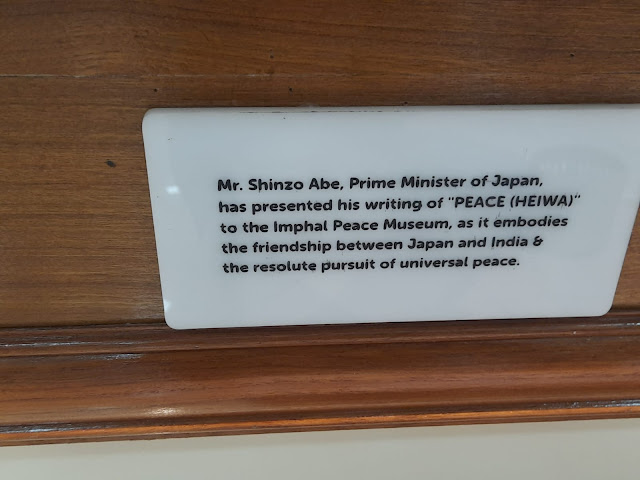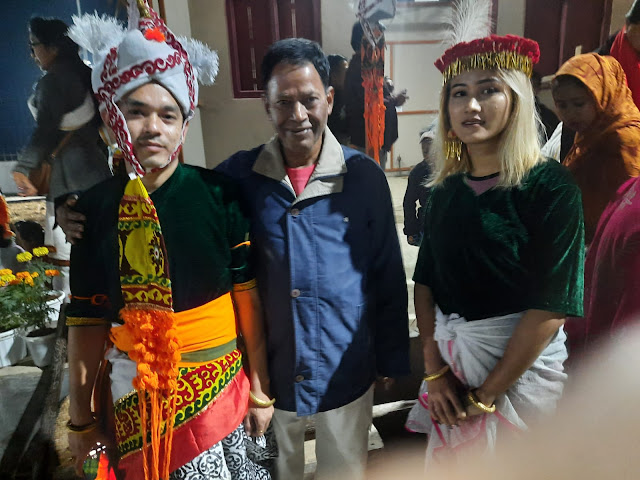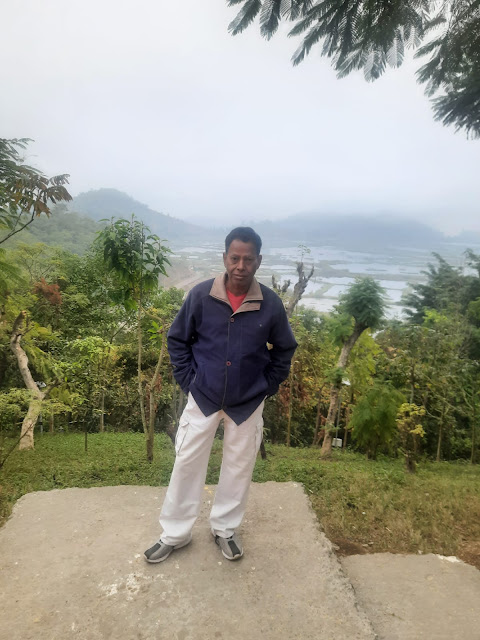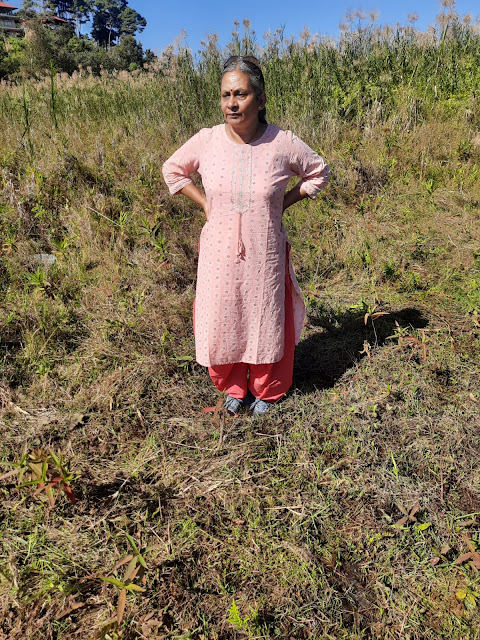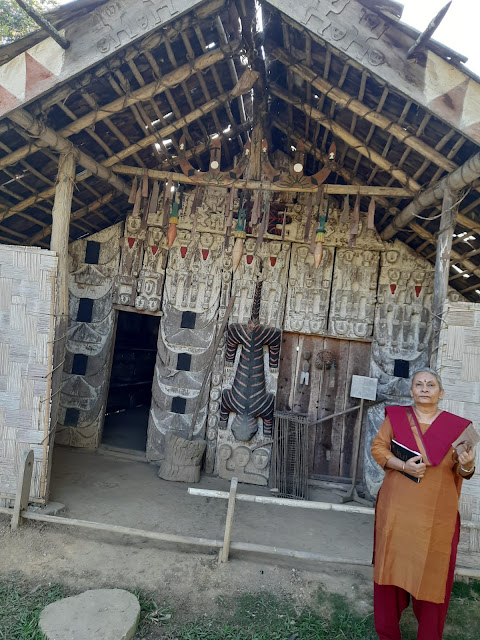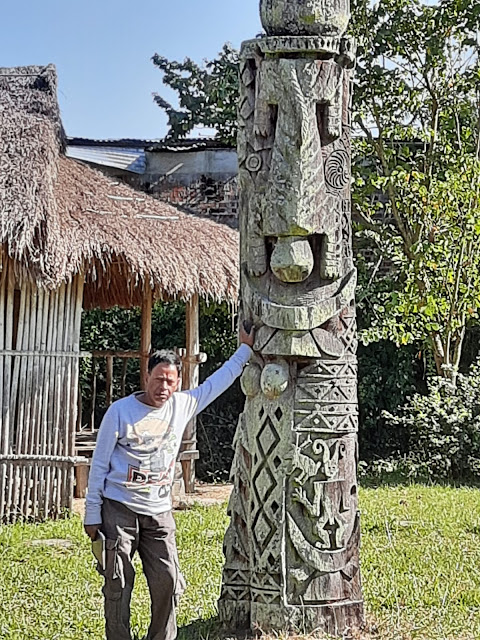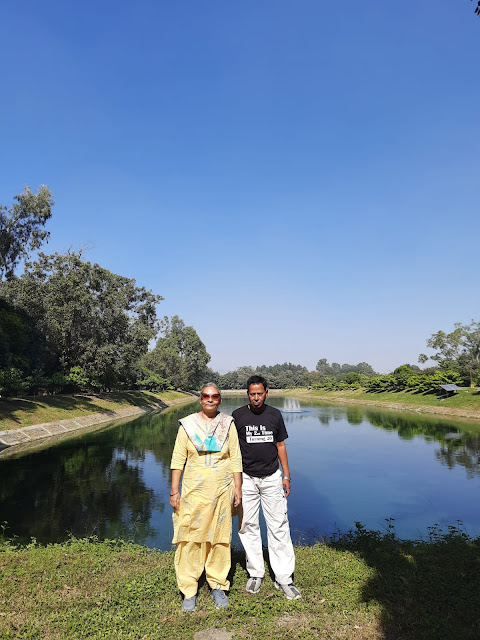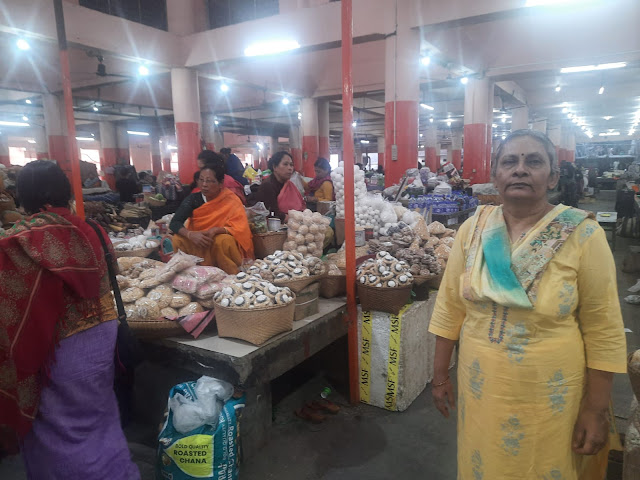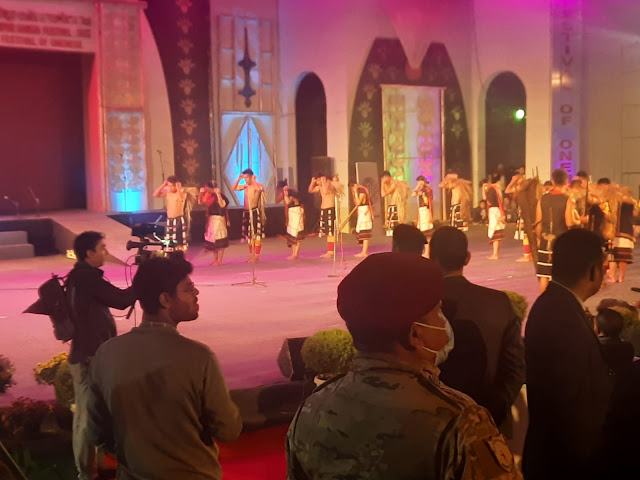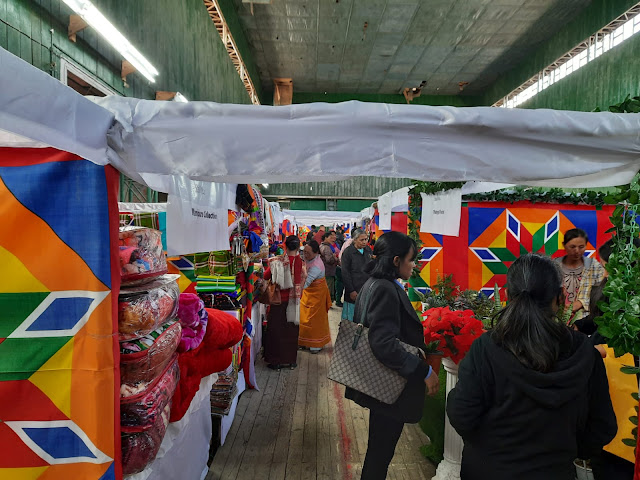Travelogue Manipur
Introducing Manipur
Manipur is one of the states of the India's Northeastern region. Since time immemorial, the different groups of people came from east and west and settled in this state. It has a distinct character of a multicultural mosaic, which are composed of various ethnic groups. There are 33 tribes which include in the Schedule List and other Non-schedule tribes along with the Meetei who lived in the valley. Culturally and linguistically, they have a close affinity to the cultures and languages of the people of Southeast Asia. And geographically, Manipur provides a land bridge and cultural corridor between Southeast Asia and India.
It is said that any one who visits Manipur falls in love and awe of this little state. Culturally rich and blooming with talent, this state is indeed the "Jewel of India".
Planning the Trip
I sent an email to Shri Binod Singh, State Information Officer State National Informatics Centre. Since I retired from Ministry of Communication and IT after serving for 31 years, I could use this resource for any information. I basically requested for the information on a reputed tour operator. Mr. Binod Singh was kind enough to send me the name, email address and telephone number of Seven Sisters Tours and Travels. I then contacted them for a possible tour package. After few iterations, we could finalize the day wise itinerary and other details. Our tour was finalized and even air tickets were booked by September itself.
We then prepared ourselves by getting as much information on the culture, and sight seeing places in slow pace. Ultimately we started the tour on 23 November 2022.
Day- 1 ( 23 Nov. 2022) – Arrival at Imphal
We reached Imphal via Kolkatta in the afternoon. While on the way to Kolkatta one can see Himalayan Mountains from the left side of the aircraft window. If the sky is clear , one can even see the mighty Everest. We were lucky to have view of Everest.
On the Imphal airport there was welcome display of Sangai festival.
At Airport with Sangai Festival Display
Inner line permit is mandatory for any person (who is non resident of the state) entering Manipur. It took us around 30 minutes. Though the staff was both courteous and helpful. Our driver Raabi was waiting for us and we came to Hotel Classic. We found the hotel very clean and well maintained.
After relaxing and freshening up, we decided to have a glimpse of Sangai festival near our Hotel at Palace ground. Even though the driver had gone home and was relaxing, he readily obliged.
A big lotus flower made of bamboos was main attraction. We heard people say that since state is ruled by BJP, their election symbol lotus is prominently displayed.
Sangai Festival Site - Palace Ground, Imphal
On the stage in the ground “Meet the Star” program was going on with Manipuri songs. Even though, the language was alien to us, we enjoyed the festive mood of people around. We came back to hotel to have dinner which was part of our package. The dinner was excellent with both Veg as well non veg dishes. The staff were very courteous and ready to serve. Went for a short walk after the dinner. Our hotel was in front of the Kangla fort. The streets and fort gate were well decorated with coloured lights. Ultimately we came back to hotel and slept.
Day 2 (24 November 2022) - Loktak Lake
After sumptuous breakfast, we checked out of the hotel as we had to go to Loktak lake and stay in Sandra Resort for the night. We proceeded for Loktak lake. On the way we saw Japanese War Memorial and Imphal Peace Museum.
Japanese War Memorial
During WW2, Japan had attacked India as it was part of British empire. As part of their campaign, they invaded Manipur. The fight is known as Battle of Imphal. It resulted in heavy losses on both sides.
The Japanese invasion took place in the region around the city of Imphal from March until July 1944. Japanese armies attempted to destroy the Allied forces at Imphal and invade India, but were driven back into Burma with heavy losses. Together with the simultaneous Battle of Kohima on the road by which the encircled Allied forces at Imphal were relieved, the battle was the turning point of the Burma campaign, part of the South-East Asian theatre of World War II. The Japanese defeat at Kohima and Imphal was the largest up until that time, with many of the Japanese deaths resulting from starvation, disease and exhaustion suffered during their retreat. According to a voting in a contest run by the British National Army Museum, the Battle of Imphal was bestowed as Britain's Greatest Battle in 2013.
(https://en.wikipedia.org/wiki/Battle_of_Imphal )
The Japanese War Memorial or Red Hill Lokpaching in Imphal is a beautiful memorial built in 1994 by the Governments of India and Japan on the 50th anniversary of 1944 battle. Red Hill was the site of some fierce fighting This site is on the way from Imphal to Moirang and Loktak lake at National Highway 150 connecting Imphal to Aizawl. The memorial is considered as symbol of peace and friendship between people of Japan and India.
The Memorial is lovely and shows reverence of the Japanese for those who fought for their country's interest and honour.
(https://www.gosahin.com/places-to-visit/japanese-war-memorial-imphal/, )
There are three stone platforms. Every year people of Japan come and pray for their ancestors who lost their lives here in WW2. The middle stone is symbol of dead persons and flowers are placed there as mark of remembrance.
Japanese War Memorial
The security persons took special interest in showing as around and explaining the importance of the place.
Imphal Peace Museum
The Imphal Peace Museum (IPM) is a World War II museum at the foothills of the Red Hills in Manipur, India. It is a living memory of the Battle of Imphal (Anglo-Japanese war) and other World War II battles (March–July 1944) fought in Manipur. It is supported by the non profit grant making Nippon Foundation (TNF), collaborating with the Manipur Tourism Forum and the Government of Manipur. The museum is the winner of India's Best Design Award in the year 2019.
The Museum was founded in the year 2019 on the 75th anniversary of the Battle of Imphal. Former British and Japanese adversaries were present in the inaugural event of the museum. Dominic Asquith, the British High Commissioner to India, and Kenji Hiramatsu, Japanese ambassador to India, attended the opening of the museum.
The museum depicts vividly by the photographs and dresses of different tribes and huts their way of life.
The Imphal war is described in great detail using posters. One of the main attractions to the museum is the display of the Japanese calligraphy of the word "平和" ("Heiwa" meaning Peace in English) by Shinzo Abe, the prime minister of Japan.
Imphal Peace Museum interior and exhibitions designs are one of the best works done by International Award-winning designer Suresh Huidrom (Principal Designer - Huidrom Design Studio). The museum has won laurels and awards in number of forums in 2019 (India's Best Design Award for the Creativity and Innovative Interior Design), 2021 (Silver Medal in the field of Interior Design at the Muse Design Awards New York City) 2021 ( finalist at the Society of British International Interior Design Award for the Best Interior Design in Public Space) and many more.
(https://en.wikipedia.org/wiki/Imphal_Peace_Museum,)
Loktak Lake
Our next stop was world famous Loktak lake.
It is the largest freshwater lake in North East India is also known as the 'floating lake' for the numerous floating circular swamps called phumdis in the local language. The phumdis float around on the lake's surface due to decay from the bottom.
This ancient lake plays an important role in the economy of Manipur. It serves as a source of water for hydropower generation, irrigation and drinking water supply. The lake is also a source of livelihood for the rural fishermen who live in the surrounding areas. The lake offers excellent opportunities for visitors to enjoy the beauty of the lake and its several islands located inside it that are studded with floating phumdis of different geometrical shapes.
We took ½ hour motor boat ride which went trough the lake crisscrossing floating islands. We wanted to get down to one of the floating islands but it was denied by the driver of the boat. Otherwise the ride was mesmerizing.
On the Boat in Loktak Lake
Sendra Resort
We then went to hill top Sendra Resort. It was 3.00 PM by that time. We were told that dinner will be served between 6.00 PM and 7.30 PM and resort will close by 8.00 PM. We got surprised. We had planned to go Moirang to see the the Sangai festival.
Moirang was one of the important venue of Sangai festival out of total 13 venues. The receptionist assured us that though the gate of resort will close at 8.00 PM, somebody will open the gate if we ring them on mobile. We quickly took bath and then went to viewpoint to see the sunset. We sat for about 1 hour at viewpoint as the atmosphere was quite serene. The sunset was not spectacular but O.K.
We could see some circular floating islands from Sendra resort. These were beautiful.
We were told that sunrise at 5.30 AM will be great.
We decided to order the dinner at 6.00 PM at room and leave for Sangai festival after dinner. As there was no restaurant nearby, we asked the driver to eat with us. We also made arrangement for the driver to sleep in the resort. However, he opted to go to Imphal after dropping us back and come back in the morning.
Sangai Festival at Moirang
Moirang festival site was the main festival venue out of 13 sites of festival. It was really very big with lot of crowd. We entered from Ethnic Park gate. There were ethnic huts of some tribes showing their way of life. We visited the huts of Meitei and Koireng tribes and took photographs along with the tribal people.
In Tribal Huts in Sangai Festival Site Moirang
At Koireng tribe hut, the tribal girls made us dress like them. We enjoyed their hospitality and their simple nature overwhelmed us. We roamed around the ethnic park. It was beautifully decorated with coloured lights.
Sangai Festival Site Moirang-1
Sangai Festival Site Moirang-2
On reaching the Sendra resort we rang up the receptionist. Somebody opened the resort gate and let us in.
Day- 3 (25 November 2022) – Local Sightseeing
We got up at 5.00 AM to see the sunrise but it was disappointment as there were clouds.
We sat down and enjoyed the nature with birds chirping and lights coming up slowly. After breakfast, we checked out of resort and went to see Keibul Lamjao National Park.
Keibul Lamjao National Park
Keibul Lamjao National Park is located in the southern parts of the Loktak Lake, which is the largest freshwater lake in eastern India. It is the only floating national park in the world and is the last natural refuge of the endangered Sangai which is state animal of Manipur.
A Bit on Sangai Deer
The Sangai is an endemic and endangered subspecies of Eld's deer found only in Manipur. Its common English name is Manipur brow-antlered deer or Eld's deer. (Eld's deer also known as the brow-antlered deer, is an endangered species of deer endemic to South Asia. It was described in detail by Percy Eld of Bengal Army in 1841. Sangai is one of the subspecies.) Its original natural habitat is the floating marshy grasslands of the Keibul Lamjao National Park.
There
if difference between antlers and horns. Where
antlers are composed of bone, horns are composed of keratin (same
material as hair and fingernails) on the outer portion and live bone
on the inner core. Antlers are shed annually; horns grow throughout
the life of the animal. Antlers grow from the tip; horns grow from
the base.
Sangai is also popularly called the dancing deer. However, it is not the Sangai that dances, but the peculiar nature of its habitat that lends this trait. While treading through phumdi (grasslands that float on water), the Sangai's hooves sink in the spongy, moist ground which from a distance looks as if it is dancing.
Beautiful Sangai Deer
(https://en.wikipedia.org/wiki/Sangai, https://en.wikipedia.org/wiki/Eld%27s_deer )
On entering the Keibul Lamjao National Park, we were guided to the Viewpoint. There, we could see the beautiful Sangai deer by Binocular. The animal was resting in the bushes. We waited for some time for animal to come out but it not in mood to please us.
Then we took boating by canoe boat.
The boatman Mr. Ratan Kumar was from Meitei tribe. He explained nicely about culture of his tribe. Pointing to a flower on the side, he explained that this flower called Nura Khudo Lao is used by Meitei boys to propose any girl they like.
Flower Nura Khudo Lao
The females who are already booked (i.e. Engaged, Married or in love) put the flower on the right ear. It simply means that somebody has already got right on them.
- If the girl accepts the flower and puts it on the left ear then the proposal of the boy is acceptable and he can take further action in this regards.
- If the girl accepts the flower but doesn't put on the ear then it means that proposal is under consideration and the boy must wait for definite response.
Like everywhere else in the world, it is boy who approaches the girl not otherwise. Most of the courtships take place during Lai Haroba fesival. Ratan further said that this age old tradition is now changing and all girls are not putting flowers on the ears.
We got down on the wet land and walked for some distance. We experienced as if we are floating as the land was moving up and down. It was really a memorable experience.
Visiting Manipur villages
We then went on to visit two Manipur villages Thanga and Karang. These two villages are situated on the opposite side of Loktak lake. After visiting a local house in Thanga, we went by a boat to visit Karang. The locals were very cooperative and allowed us to enter their homes and explained their way of living. Our driver cum guide acted as interpreter.
The villages are slowly moving towards modernity. We didn't find anything specific to tribal life.
The Loktak lake plays very important role in their lives as it provides them water for drinking, other activities and fish as well. We visited the village market where dried fishes of different varieties were being sold.
Dried Fish Shop in Karang Village
Handloom in a village house
Every house has a handloom using which the villagers weave shawls, ladies scarves and other clothes. Fishing and weaving is their means of earnings. In short, we felt that the people are leading hassle free and contented life.
Visit to INA Museum
Then we proceeded to visit museum dedicated to Indian National Army (INA) of Netaji Subhash Chandra Bose in Moirang. The Moirang town was central place of INA and Netaji Subhash Chandra Bose. The museum illustrates the collaboration of Japanese and Subhash Chandra Bose by different photographs. It also has a collection of letters, photographs, badges of ranks and other war memorabilia reminds the noble sacrifices made by the INA soldiers. Photography was not allowed in the museum.
INA Museum
The place where Tri coloured Flag of India was unfurled for the first time before Independence is in the museum compound. It was Netaji himself who unfurled the tri coloured flag on April 14, 1944. A bronze statue of Netaji Subash Chandra Bose in uniform stands along with tri coloured flag at the place.
Place
where Tri coloured flag was first unfurled
Then we went back to Imphal and reached Classic hotel in the evening.
On this day there were number of marriages in the Manipur and we saw quite many marriage processions on the way.
The marriage party of of groom were dresses in white or cream including the groom. On reaching the hotel we inquired from receptionist and were told that marriages in Manipur are very simple and take around 2 hours to complete. After that bride and groom proceed to groom’s place. Only tea/coffee and light snacks are served. In contrast to North Indian marriages, there is no dance in the marriage procession and also number of guests is limited.
Typical Manipuri Marriage Procession
Since we were tired, we decided to relax in the hotel.
Day- 4 (26 November 2022) - Visiting Kaina and Andro villages
Shri Govindaji Temple, Kaina Village
Our day started with the visit to Shri Govindaji Temple in Kaina village.
Kaina
is a beautiful hillock around 29 KM from Imphal situated about 921
meter above sea level. It is a holy place for Hindus and has a
temple dedicated to Shri Govindaji (i.e. Lord Krishna).
According to legend, one night, Shri Govindaji appeared to his devotee Bhagyachandra Maharaja (1763-98 AD) of Manipur, in a dream and asked him to construct a temple enshrine with his image carved from the parts of a Jack fruit tree cut from Kaina. Later, this temple was built by the Bhagyachandra.
Beautiful
Hill shrubs and charming natural surroundings give the place a calm,
virtuous and earnestness. It is peaceful place gifted with
picturesque location. One feels in the harmony with the nature.
Meitei community regard the temple very sacred and visit as part of all occasions in the family. We witnessed a prayer being performed one year after death of a person by his near relatives. Blue Lotus (Neel Kamal) is offered to the deity.
The priest was very pious and offered us ashirwad and blue lotus and apple as prasad. The vibration of the temple was very positive and could be felt by us.
Shri Govindaji Temple Kaina
Kaina Village
Visit to Andro Village
Andro is a small Chakpa village situated about 26 km from Imphal in the eastern side. It has a distinct identity of its own by preserving the age-old cultures and traditions. The practice of fire worshipping is still continued in the temple of Panam Ningthou. It is prepared in turn by the every house-hold member of the village. The community of Andro has occupied a major portion in the map of traditional pot making culture.
During 1700 onward, the king pushed all of Imphal valley to convert to Hinduism. However, a small group of Meiteis chose to become social castaways in order to continue practicing their indigenous Sanamahi faith. An even smaller group of their descendants live in Andro village today, and still practice their prized heritage craft, the rare pottery form of Charai Taba.
Interestingly, this is an art form practiced only by married women, and generally passed on to young brides by their mother-in-law.
Cultural Heritage Complex, Andro
The residents of Andro are keen on upholding and preserving their slowly-disappearing traditions and customs. This is why in 1993 (under the guidance of noted anthropologist, writer and numismatist Mutua Bahadur) the villagers established a cultural complex-cum-museum that has since become the heart of the village.
The Cultural Heritage Complex encompasses all the material cultures of different ethnic groups of Manipur along with their own styles of traditional houses. From pretty paintings and handcrafted tribal dolls (that depict the traditional attires of the 29 recognized tribes of Manipur) to stone figurines and wood carvings of local legends, this museum is a stunning display of Andro’s cultural legacy. However, the Andro’s unusual style of pottery is the cynosure of all eyes at the museum.
In
this Complex, the items are displayed into two broad categories.
First category has exhibits within the traditional houses of different indigenous groups of Manipur.
The materials, displayed in the house, are arranged in manner that the common people used. The different traditional houses of the indigenous people of the Complex are made of the traditional raw materials.
After finishing of construction, each and every house was inaugurated by performing traditional rituals and practices. All the houses of the Complex were well exposed in the smoke about 3 months. This was to protect them from the untimely decay and invasion of insects and worms. This is the traditional method of preservation which was followed.
Traditional Houses of different Indigenous Groups
The
second category is outdoor exhibition. Here,
the different cultural practices of stone monuments of the tribal
groups are displayed of Manipur in the form of models. About 33
indigenous groups are exhibited using pillars with different symbols.
The idea is is to preserve and exhibit the cultural symbols of
indigenous people.
Stone Monuments of the Tribal Groups
The
Complex is truly unique as it preserves and maintains the cultural
history of indigenous tribes of Manipur.
Andro Village House
We visited a typical village house and witnessed pottery making and rice wine and beer preparation.
Traditional Pottery Making Process
We discussed with the lady of the house regarding the process of wine and beer making using rice. What she told us is -
- Rice is put in water for four days and gets fermented.
- It is then boiled and fumes are distilled to get rice wine.
- The left over rice is again put in water.
- After few days, it gets fermented again and fumes are distilled to get the rice beer.
- The left over rice is fed to the pigs.
Rice Wine and Beer Preparation
The lady of the house told us that pottery making and rice wine and beer preparation are the main bread earner for the family.
We met a lady named Padmini Konsum who has taken initiative to popularize the traditional pottery making using hands. She left her job in Delhi to take up this task. Originally settled in Delhi, she regularly visits Andro and works with locals in Pottery making.
The aim of her project, initiative and drive are really commendable.
In the Company of Ms. Padmini Konsum
Visit to Andro Park
We then visited Andro park (Cultural Heritage Complex, Andro). It nice place for picnic with lots of trees, cultivated forest and also a lake. Number of families had come there for picnic. There were quite a number of love birds roaming around. We spent around 2 hours there walking and enjoying the surroundings.
Andro Park
Visit to Sacred Fire Place
We then went to visit Famed Fire Place where fire is burning since 1BC. The fire is being burned using firewood by a group of persons belonging to a family.
The place is considered sacred by the local community.
Sacred Fire Place
Sangai Festival, Imphal
We then returned to Imphal. On coming back we quickly freshened ourselves and proceeded to Sangai festival venue. We directly went to B.O.A.T (Bhagyachandra Open Air Theater), the site of dance performances.
Outside BOAT
We could see the following dance performances.
Northeast Cultural Mosiac
Ballet Dance called Taret.
Jugalbandi
There was Drum Jugalbandi of Drummers of Japan and Manipur Drummers with Mao humming.
Sangai Medley
At the end, Sangai Medley was held where all the artists who had performed that day presented joint performance of music and dance.
All the performances were superb and enthralling.
Day-5 (27 November 2022) - Local Sightseeing
Kangla Fort
Situated close to the banks of the Imphal River, the Kangla Fort or Kangla Palace is a symbol of Manipur's glory. The word ‘Kangla’ means dry land in Manipuri or Meetei language. Kangla was the ancient capital of Manipur and a number of Meetei monarchs have ruled the destination from this fort.
The existence of this fort dates back to 33 AD, when the mythical God-King of Manipur, Nongda Lairen Pakhangba first ascended the throne. It was gradually renovated and developed by successive kings who ruled the place. In 1891, it was taken over by the British army after the Anglo-Manipur War. Later, the Assam Rifle took control of it, until 2004. On 20th November 2004, the Kangla Fort was handed over by the Indian Prime Minister Manmohan Singh to the state government of Manipur.
Kangla Fort is signature of history of Manipur and is well kept. We took a guide with battery operated cart. The guide ‘Lancy’ was very knowledgeable and explained very well about the historical significance of various parts of the fort.
Royal Boat House
The Hijagang is a boatyard building inside the Kangla Fort, It houses 4 traditional Meitei watercrafts, including 2 Hiyang Hirens (race boats of Meitei royalties) and 2 "Tanna Hi"s (race boats of Meitei commoners). According to Meitei religious beliefs, the Hiyang Hirens are used by the male ancestral deity (Meitei: Ibudhou) and female ancestral deity (Meitei: Ibendhou) and are holy to the Meiteis, the major ethnic group of Manipur.
Royal Boat House
Great Grand Temple (Ipudhou Pakhangba Laishang) of God Pakhangba
The Iputhou Pakhangba Laishang, also known as the 'Temple of our Great-Great Grandfather Pakhangba'), is a Meitei temple dedicated to the God Pakhangba of Sanamahism, the traditional Meitei religion. It is a recently-constructed temple dedicated to the dragon God Pakhangba and an example of Meitei architecture.
The construction was carried out by the Manipur Police Housing Corporation under the aegis of the Kangla Fort Board between December 2008 and January 2019.On the 19th of February 2010, along with the performance of religious rites and rituals by priests (Meitei : Maiba) and priestesses invoking the God Pakhangba at Nungjeng Pukhri Macha, the Ibudhou Pakhangba Temple was consecrated (declared sacred ) along with a Hiyang Hiren (royal boat). There was also religious procession with priestesses offering Maibi Jagoi to the music of the pena from the Nungjeng Pukhri Macha to the temple.
The
major architectural designs for the 48-feet high Pakhangba temple are
the sacred altar
dedicated
to God Pakhangba and the seven-coloured flag designed roof,
symbolising the seven Meitei clans.
During November 2018, Maha Chakri Sirindhorn, a princess of Thailand, visited the Ibudhou Pakhangba Temple as a part of her visit to Manipur's Sangai festival.
Great Grand Temple of God Pakhangba
Polo Ground
It is well known that Manipur has given the game of polo to the world. The polo field (also known as Manung Kangjeibung locally) located inside the Kangla Fort is considered as birth place of polo. In ancient times, only royalties and nobilities were allowed to play the game of polo in this royal playground.
Polo Ground- Birth Place of Polo
It is said that King Ningthou Kangba used to play the game of polo in this very ground. Later, the polo field was developed during the reign of King Marjit Singh (1813-1819).
Kangla Museum
The Kangla Museum showcases the lifestyles of royalties, ancient artistic and cultural heritage and maps of Manipur. In the year 2018, alongside the annual Sangai festival celebrations, the Kangla Museum was visited by Maha Chakri Sirindhorn, the princess of Thailand. No photography is allowed inside the museum.
Kangla Museum
Kangla Sha
In Meitei mythology and religion, Kangla Sha is a guardian dragon lion. It has a lion's body and a dragon's head, with two horns. It is considered sacred to the Meitei heritage. It is a royal symbol of the Meitei royalties. It is believed that Kangla Sha is guarding the Manipur.
Kangla Sha
In Meitei traditional race competitions, winners of the race are declared only after symbolically touching the statue of the dragon "Kangla Sha".
(https://en.wikipedia.org/wiki/Kangla_Palace, )
Inside Kangla Fort
Govindaji Temple
Shree Govindaji Temple is the largest Vaishanava temple in Imphal. The temple is dedicated to Hindu deities Radha Krishna (Govindaji). It was originally built in 1846 during the reign of Maharaja Nara Singh and later rebuilt by Maharaja Chandrakriti in 1876.
The temple is simple in design with two gold plated domes, a paved court and a large, raised Mandop or congregation hall. The central chamber of the garbhagriha (sanctum sanctorum) has Govindaji (Krishna) and his chief consort Radha as the main deities.
Shri Govindaji Temple, Imphal
The other two chambers on the either side of the central altar is dedicated to Krishna and Balarama on one side and Jagannath, Subhadra and Balabhadra on the other side. Jagannath (considered as an abstract representation of Krishna or Vishnu and sometimes as the avatar of Krishna or Vishnu.) is worshipped as part of a triad along with his brother Balabhadra (Balrama) and sister, Subhadra.
The temple appears very elegant and is built in an idyllic location with a well tended garden surrounding the premises. There is a small pond in the vicinity of the temple, and also a large open space where a row of tall trees are planted along the boundary. The Meitheis, an ethnic group of Manipur, are the ardent devotees of the Lord of this temple.
When we reached the temple, the arti was over and gate of deity were closed, But we could get the Bhojan Prasad which was highly recommended. It is traditional Manipuri food served on banana leaves. It is very delicious and must be had by all visitors of the temple.
(https://en.wikipedia.org/wiki/Shree_Govindajee_Temple,)
Imphal War Cemetery
The Imphal War Cemetery has 1,600 Commonwealth burials of the Second World War and is maintained by the Commonwealth War Graves Commission. Many of the people buried in the cemetery were killed during the Battle of Kohima and Imphal.
During the Second World War, in 1942 the Japanese Army occupied Burma by defeating the Commonwealth forces. Considering Imphal’s strategic importance, the Japanese forces attacked Manipur in the spring of 1944. The Japanese started bombing Imphal, severed a part of the road link between Imphal and Dimapur and held siege over Imphal for over three months. The 14th Army of the Commonwealth Forces fought fiercely and caused many casualties of the Japanese forces.
This battle has been termed as the "Normandy of the east". It is reported that during the Second World War, the number of dead in the Kohima and Imphal sectors in India, put together, was 65,000 Japanese troops and 18,000 British and Indian soldiers. The siege of Imphal was lifted in the summer of 1944 and the battle ended on 22 June 1944.
Initially, the cemetery had 950 burials of war dead. Following the end of the Second World War, the burials in two other smaller cemeteries in Imphal and in other isolated locations were also shifted to this cemetery taking the total war burials at the cemetery to 1,600. The memorial has markers with brass plaques with the name of each of the fallen. The war dead commemorated are from many commonwealth countries, such as 1300 from the United Kingdom, 10 from Canada, 5 from Australia, 220 from India, 40 from East Africa, 10 from West Africa and 10 from Burma.
Imphal War Cemetery
A memorial service was organized at the cemetery on the occasion of the 70th Anniversary of the Battle of Imphal (WWII) on 27 June 2014. V.K. Duggal, the Governor of Manipur, the Deputy Chief Minister of Manipur, Director, Commonwealth War Grave Commission, the First Secretary, Australian High Commission to India, Military Attache in the Embassy of United States, Chairman and Members of the Manipur Tourism Forum and 2nd World War Imphal Campaign Foundation were the dignitaries present on the occasion. V.K. Duggal and other members placed wreaths on the graves.
(https://en.wikipedia.org/wiki/Imphal_War_Cemetery, )
RKCS Art Gallery
RKCS
Art Gallery was founded in 1990 by the legendary artist RajKumar
Chandrajitsana Singh (RKCS). It has been operating as a full-fledged
gallery since 2003. RKCS was a renowned artist of the state who
created over 10,000 paintings on varied subjects, including
mythology, history and culture. His paintings have received accolades
from art lovers across the globe. The gallery displays different
facets of the state of Manipur through beautiful paintings.
A Bit on the Artist
Raj Kumar Chandrajitsana Singh(RKCS), was born in the family of pioneer artists in Imphal in the year 1924. His father RajKumar Yumjaosana Singh and his grandfather RK Gour Singh were both extremely talented artist from 19 th century. It was natural he would join the clan and the blessed artistic genetics only bloomed with his age.
In the year 1947, he established his first art studio under the banner "RKCS Chitralaya". And gradually the dream of RKCS for a full-fledged art gallery was formally inaugurated on 5th May,2003. His work has been loved and won laurels with many prestigious awards such as Shilpa Bhushan in 1981, Award of Fellow by Manipur State Kala Academy in 1989. He made it to the Limca Book of Records in 1994 for exhibiting highest number of paintings by a single artist. He also received Chitrakala Ratna by Manipuri Sahitya Parishad in 2005, posthumously.
RKCS Art Gallery is now being maintained by his son, Mr RK Budhimanta and grandson Mr RK Busho.
It is beautiful gallery of paintings by RajKumar Chandrajitsana Singh(RKCS) who painted 1000 paintings to restore the lost culture and glory of Manipur. Photography is not allowed inside the gallery.
The Historical section depicts vividly the turmoil and sufferings of Manipur people by Ahoms, Burmese, Britishers and Japanese. One can’t help but getting respect for the resolve of Manipur People for survival.
Two paintings show women just after taking bath. They are both beautiful and erotic.
IMA Market
The Ima Market (Meitei: Ima Keithel literally, Mothers' Market), is a market in the middle of Imphal. It is the only market in the world run entirely by women. Inside the market, male shopkeepers and vendors are not allowed to sell anything. It was established in the 16th century and hosts around 5,000–6,000 women vendors who sell a variety of products. Products such as vegetables, fruits, textiles, toys, fish, spices and utensils are available in the market.
A Bit of History
The market was established in the 16th century following the imposition of the labour system, lallup-kaba in 1533 which required male members of the Meitei ethnicity to work in distant lands or to serve in the army. As a consequence, women had to support their households by cultivating their fields or weaving textiles and then selling the products on improvised markets. The improvised markets led to the formation of the organized Ima Keithel.
In 1891, the British colonial administration attempted to impose economic and political reform in Manipur Kingdom which disrupted the functioning of the market. The reforms involved large scale seizure and export of food corps from Manipur without consideration for local requirements which caused starvation at times of Mautam.
Mautâm is a cyclic ecological phenomenon that occurs every 48–50 years in the northeastern Indian states of Tripura, Mizoram and Manipur, as well as in many places of Assam which are 30% covered by wild bamboo forests.
During mautâm, Melocanna baccifera, a species of bamboo, flowers at one time across a wide area. This event is followed invariably by a plague of black rats in what is called a rat flood. This occurs as the rats multiply in response to the temporary windfall of seeds, and leave the forests to forage on stored grain when the bamboo seeds are exhausted, which in turn causes devastating famine.
Bamboo Species that Flower once in Human Life Time
(https://en.wikipedia.org/wiki/Mautam,)
It led to agitations by the women of the Ima Keithel and in response, the British attempted to sell off the assets and properties of Ima Keithel to foreigners and external buyers. This among other causes resulted in the Nupi Lan or the women's war, which eventually seized with the Japanese invasion of India.
Following independence, the market regained prominence as a commercial center. In 2010, the market was moved into the Khawairamband Bazaar complex constructed by the Municipal Corporation of Imphal. The complex had sustained damaged in the 2016 Imphal earthquake which effected the livelihood of around 800 vendors.
The complex consists of three large buildings with pagoda styled roofs. It is split into two sections on either side of the road. The market houses around 5000–6000 women vendors at any given day. The market is managed by a union of all the vendors of the market. It maintains a custom of only allowing women who have been married at least once to set up stalls. The women vendors include those who are divorced or have been widowed in the insurgency in Manipur.
Visiting ‘All Women’ market was a delightful experience. It is surprising to see the marketing skills of women shopkeepers. Almost all women were having flower on their right ear announcing their marital status. Almost all shops had winter clothes considering the season. We wanted to purchase some souvenir gift items for our children but it was not available, Fortunately we had purchased few coffee mugs with Sangai photo in Kangla fort information centre. Here we did buy some small items after bargain.
(https://en.wikipedia.org/wiki/Ima_Market )
Sangai Festival
We reached the B,O.A.T. Sangai festival site at 5.00 PM. Today Shri Shiv Raj Singh Chauhan Chief Minister of Madhya Pradesh and Shri N. Birendra Singh, Chief Minister of Manipur were the Chief Guests. After speeches by chief guests, the cultural programs started.
Various dance performances were -
Saiyal Turet by Khura---- Kala Bidya Bhavan.
Traditional Dance by MAO Tribe
Badhai Ho Badhai Dance by dancers from M.P.
This was added to show the importance of the chief guest - the Chief Minister of M.P.
Dances from Thailand
It had six items. The item No. 5 had puppet show. Here two puppets – a boy and a girl were acting. It was superb. The boy puppet roamed around the theater in pursuit of the girl puppet. It also interacted with the audience to to know her whereabouts.
Thailand Dance -1
Thailand Dance -2
Thailand Dance -3
Thailand Dance -4
Thailand Dance -6
Since it was getting late, we had to leave for the hotel. There were 4 more dance performances remaining that we had to miss.
Day- 6 (28 November 2022) - Govindaji temple and Sadu Chiru Waterfall
Visit to Govindaji temple, Imphal
Today morning after the breakfast, we decided to visit Govindaji temple again and try to get darshan of deity. In the nick of time, we were successful in attaining darshan of the deity. We attribute it to God’s grace. We spent some more time in the temple to absorb the peace and tranquility of the atmosphere there.
Successful Visit to Govindaji Temple
There was a prayer meeting was going on in the Mandop. We sat there for some time and got very pious feelings.
Prayer Meeting at Govindaji Temple
Visit to Sadu Chiru Waterfall
We the proceeded to visit Sadu Chiru waterfall in Senapati.
Sadu Chiru Waterfall is around 25 KM from the Imphal. It is also popularly known as as the Leimaram Waterfall. The route to the falls initially cuts through the forest and foliage. En route there are affluent crop field and small streams that add a unique charm in the pathway. The best thing is that it is not commercialized as yet. There is only one shop which sells tea and pakoras. We had delicious pakoras and tea before going to the fall.
There are stairs one has to take to reach near the fall.
When you climb the stairs you encounter nature in beautiful form with trees all around, birds chirping and sound of falling water. The valley from which the waterfalls surrounds is profusely green and extremely alluring
On the Way to Waterfall.
The stairs are not well kept and there is a section where stairs are broken and it becomes risky adventure to reach the waterfall.
Cascading from a height of nearly 300 metres, Sadu Chiru Waterfall makes an enthralling sight. The mist emerging from the water that disperses in the surrounding is something that conjures up the images of serenity.
Sadu Chiru Waterfall
We sat down there for about 30 minutes enjoying the nature.
Spending Time with Waterfall
I went further walking up and down the mountains to reach the actual fall as I wanted to be nearest to the falling water.
Near the Waterfall
After we reached back the base, we again had tea and Pakoras.
The public toilets are dirty. Government must pay attention to the development of stairs and upkeep of toilets to make the place more tourist friendly.
(https://www.tourmyindia.com/states/manipur/sadu-chiru-waterfall.html )
Sangai Festival
We reached back the hotel and after freshening up proceeded to B.O.A.T Sangai festival site. We could witness following enthralling dance performances:
Traditional dance of Moyon tribe
Odissi Dance by Dancers of Orissa
Sambalpuri Folk Dance of Orissa
Loktak Dance by Nongeen Arts and Culture Association
Vande Matram Dance by Dancers of West Bengal
The complete audience present were filled with patriotic fervour and gave standing ovation after the dance was over.
Cheraw Dance (also known as Bamboo Dance) of Mizo Tribe
Thang Tu – Manipuri Martial Art Dance
There were three more dance performances remaining but we came back as it was getting late.
Day- 7 (29 November 2022) - Sanamahi temple and Ukhrul
After breakfast we said temporary goodbye to Hotel Classic as were going to stay overnight in Ukhrul.
Short visit to Sanamahi temple
We started from the hotel and visited Sanamahi temple. The temple belongs to meitei tribe as they practice the Sanamahi faith. It is quite small, clean and well maintained temple.
Visit to Mova Cave
On the way to Ukhrul, we decided to visit Mova Cave. The cave is the forest. We went inside the forest on a hazardous road which was broken completely. After around 45 minutes journey in the forest, we reached the point where we had to get down from the vehicle and proceed for the cave. We then realized that we have to go down on a path which was dangerous as there were no stairs or railings. We were therefore forced to abandon the idea of cave and we proceeded to Ukhrul.
The Government should develop the approach road and proper stairs if Mova cave is on tourist map of Manipur.
A Bit on Ukhrul
Ukhrul ( also known as Hunphun) town is the home of the Tangkhul Nagas. 84 KM from Imphal, it is the administrative headquarter of the Ukhrul district. Ukhrul shares an international boundary with Mynamar on its eastern side and is bounded by Nagaland state in the north. It has the distinction of being the highest hill station of Manipur. The Tangkhul Naga tribe constitute the major bulk of the population(87%) with other communities such as Thadou, Nepalese and other non-tribal groups constituting a small percentage of the district population.
The Ukhrul district is famous for Shirui Lily the state flower of Manipur. Also known as Lilium Macklinae. it is a rare pinkish white flower found only in the Shirui Hill Range in the Ukhrul District. It blooms only in May – June months. It is named after Jean Macklin, the wife of Dr. Frank Kingdon-Ward who spotted the flower in 1946 while collecting botanical specimens. The Royal Horticultural Society (RHS), London, United Kingdom. one of the world's leading horticultural organizations honoured the Shirui Lily with its prestigious merit award at its Flower Show in London in 1948.
Shirui Lily now faces a crisis of possible extinction in the near future due to climate change, deforestation, wildfire, poor conservation approaches, intrusion of other plants and bushes, over exploitation etc. It has been categorized as an Endangered species.
(https://en.wikipedia.org/wiki/Ukhrul, https://en.wikipedia.org/wiki/Lilium_mackliniae )
We reached Ukhrul at around 5.00 PM. Being hill station, Ukhrul was quite cold as compared to Imphal.
AVA Market
On entering Ukhrul, we went to visit AVA market which is managed by women only. It is quite clean and fried and live fishes were sold. We took tea without milk. Though, there were many fried items were being sold for eating we didn’t venture it.
AVA Market, Ukhrul
Tribal Expo
Next to Ava market was Tribal Expo. In it tribal were selling many items, mostly woolen shawls, jackets and other clothes made by Manipuri people. Some handicraft items as showpiece were also on sale. Many shops were selling western clothes as well.
Shalom Lodge
Ultimately, we came to our place of stay – Shalom Lodge. It is managed by a single family of father, mother and daughter. They welcomed us warmly. The lodge has very basic facilities but was clean and comfortable. After dinner, we took a short walk of the town. Since, it was very cold we asked for a room heater which was promptly provided. The family made all efforts to make our stay comfortable.
Day- 8 (30 November 2022) - Ukhrul Sightseeing
Morning View of Ukhrul
We got up a little early to witness the early morning view of surroundings from Shalom Lodge. The view was excellent and unique. It was as if the clouds were touching the ground. What we witnessed was beauty of nature at its best.
Morning View - Ukhrul
We had breakfast in the terrace itself.
Breakfast Time
Strength of Unity statue
After breakfast, we started our tour of Ukhrul. Our first point was Strength of Unity Statue situated in Shirui village. The statue depicts five man carrying tree trunk on their shoulders showing that unity is strength. It was designed by Ukhrul sculptor Shoreishang Keishing. It was inaugurated on 16 October 2019 as mark of opening of 3rd Shirui Lily (4 day state festival) festival 2019.
Strength of Unity Statue
We stopped at number of places on the way to get the view of beautiful valley.
Ukhrul Valley View
Pneumonia Viewpoint and Camping site
Our next stop was Pneumonia Viewpoint. The view of the valley was excellent. It was quite refreshing to be with the nature. We could feel clouds hovering around us. The viewpoint is famous camping site and picnic spot all year round.
Pneumonia Viewpoint
Longpi Kajui Village
We then proceeded to village Longpi Kajui (also known as Nungbi Kajui where we went to meet Mr. Machihan Sasa, inventor of process to make black pottery.
A Bit on Black Pottery
Even
though, most of the villages of Manipur make their trademark pottery,
each determined by its colours and designs, Tangkhul Naga Tribe
residing in the Nungbi village has made a mark with its black
earthenware.
The technique of this art is said to be
handed down from the Neolithic period. A unique feature of this craft
is that it is crafted without a potter's wheel. Clay and black rock
are the two main ingredients used for this craft. The craft requires
a high degree of skill and attention.
The baked pots
acquire a black colour and look almost like metal. It is generally
believed that cooking in this pottery enhances the taste of the food.
This pottery has attained an important place in handicraft products
outside Manipur.
Among the makers of this particular type
of pottery Machihan Sasa is also a pioneer. Machihan Sasa was born on
April 10, 1950 at Nungbi Kajui or Longpi Kajui village. He learnt the
art of pottery making from his late father Kuishim Sasa at the early
age of 20. He had started making pottery items from 1970
onwards.
Under
the guidance of Machihan Sasa many interested villagers were trained
under the sponsorship of state authorities and other implementing
agencies. Machihan Sasa is recipient of many awards both at state
and national level in designing and promoting black pottery. He was
awarded the State Award to Master Craftsman for the year 1986-87. He
also received Special Award from Deputy Commissioner of Ukhrul
district on November 28, 1987. He was awarded the National Award from
the President of India under the Ministry of Textiles Government of
India in 1988.
In 2010, Machihan Sasa got the prestigious Shilp Guru Award which is the highest Award after the National Award. All his three sons and his lone daughter have joined him in this venture and have also won national and state awards in pottery.
Shilp Guru Award
We found Machihan Sasa a very simple person. He greeted us warmly and explained the process. We saw the photographs of him receiving award from Mr. Venkataka Raman, Hon’able President of India and many other dignitaries. There was a photograph with Mr. Rahul Gandhi also. There was also a car which was reportedly given by Mr. Rahul Gandhi.
We were very much impressed by his simple nature with no ado about his success and awards.
In the Compound of Black Pottery Production
In the Company of Machihan Sasa
After spending considerable time with this down to earth personality, we came back to Shalom Lodge and started our journey to Classis Hotel, Imphal.
The family owning the lodge came to bid us good bye and safe journey.
Last Dinner at Classic Hotel
We reached hotel Classic around 6.00 PM. Since it was last day of Sangai festival and and as per program, only closing ceremony was to take place we decided to take rest. We freshened up, took tea and took rest. At around 8.00 PM, we went for our last dinner in the restaurant.
While picking our dishes from buffet, I got in to conversation with another guest who was from Mumbai.
“You know people here widely consume beef”, he said.
“I don’t think so. It is BJP ruled state who are die hard Gau Rakshhak”, said I
“I also thought so but it seems that beef is staple food here and state government has allowed cow slaughtering”, said he smilingly.
I didn’t prolong the discussion but was uncomfortable. After dinner I checked the internet on beef eating in Manipur and found to my astonishment that he was correct and indeed cows are slaughtered and beef is widely consumed.
In fact, back in June 2017, Chief Minister Shri Biren Singh had declared -
BJP has no issues with Northeast's beef eating: Manipur CM Biren Singh
NEW
DELHI: Beef is an integral part of people’s diet in Northeast India
and the BJP, which leads the ruling coalition in Manipur, does not
intend to dictate food choices to people, chief minister Biren Singh
told ET on Sunday.
I kept thinking about it in the night and ultimately came to conclusion that -
AT THE END WHAT COUNTS FOR A POLITICAL PARTY IS VOTE. NOT IDEOLOGY. If ideology comes in the way of garnering votes then it must be discarded.
IT IS TRUE FOR ALL POLITICAL PARTIES.
Day- 9 (01 December 2022) - Departure for Delhi
Today, after breakfast, we checked out and bid goodbye to Classic Hotel. The staff and officers took special care to make our stay comfortable and always served us with smile. All the boys and girls were very nice and energetic. I complimented Ms Bina Pani at the reception and asked her to convey our appreciation to her colleagues.
We took flight from Imphal to Kolkatta and then Kolkatta to Delhi. At Imphal Air port, we returned the Inner line permit issued while entering the Manipur.
While on the return flight, we were reflecting our experience during past 8 days in Manipur.
- We travelled by road to Loktak lake and also to Ukhrul.
- We also visited Govindaji temple in Imphal and Kaina village and Sanamahi temple in Imphal.
- We went to Sangai festival in Morang and B.O.A.T Palace ground in Imphal
- We also went to IMA market and various sights in Imphal.
During our complete stay-
* We didn’t encounter any stray animal like cow or dog on the road.
* The night sky was full of stars.
These were in contrast to Delhi and other places in North India.
* We also didn’t encounter any pundit (priest) asking or expecting any money. No body in temple asked us for any special puja to extort money from us.
This experience was in contrast to temples in Mathura, Varanasi and even Kolkatta.
Overall our experience was very positive and we would like to visit again.
At the end we love our country which is Secular, Multicultural, Colourfull and Beautiful.
https://kantscorner.blogspot.com/2023/02/travelogue-manipur.html
*******





